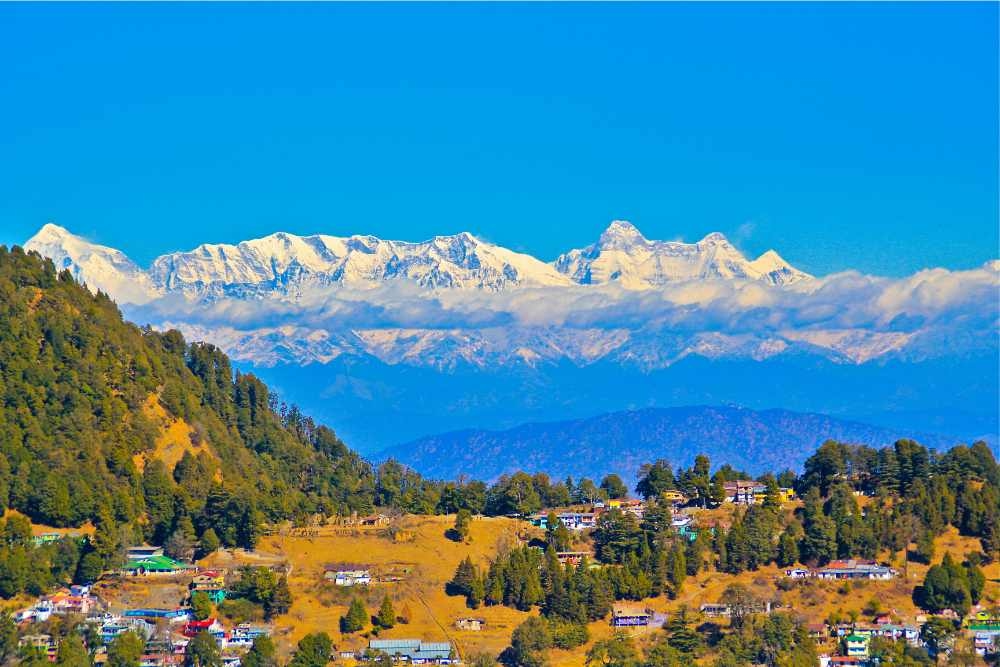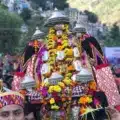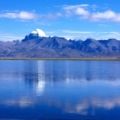The Himalayas have long represented awe and wonder for travellers and explorers worldwide. Whether it’s the mystical allure of ancient temples, the serene beauty of snow-capped peaks, or the thrill of challenging treks, a Himalaya tour offers an unforgettable experience. Known as the “abode of the gods,” the Himalayan range stretches across five countries: India, Nepal, Bhutan, China, and Pakistan, offering some of the most incredible landscapes and spiritual experiences on Earth. In this article, we’ll take you on a journey through the heart of the Himalayas, highlighting key Himalaya tourist places, exploring the division of the Himalayas, uncovering the secrets of Himalayan peaks, understanding the Himalaya temperature, and giving you insights into Himalaya trip packages and Himalayan treks for beginners.
1. The Division of the Himalayas: A Geographical Marvel
The Himalayan mountain range is divided into three major regions: the Himalayan Outer Range, the Inner or Greater Himalayas, and the Trans-Himalayas. This division provides a stunning variety of landscapes, offering adventurers different experiences.
- The Outer Range (Shivaliks): This is the outermost foothill range of the Himalayas. With its lower altitude, the Shivaliks are characterised by lush green valleys, rich biodiversity, and rivers originating in the upper Himalayan regions. This part of the Himalayas is ideal for beginners or those looking for more relaxed tours.
- The Middle or Lesser Himalayas: Nestled between the Outer and Greater Himalayas, this region is home to beautiful hill stations, bustling towns, and high-altitude lakes. Popular Himalaya tourist places in this region include Manali, Dharamshala, and Nainital. The terrain here is more rugged, offering several treks for both beginners and experienced trekkers.
- The Greater Himalayas (Himalayan Peaks): This region is the most challenging and remote, with some of the world’s highest and most majestic peaks. Mount Everest, Kanchenjunga, Nanda Devi, and Dhaulagiri are just a few of the Himalayan giants that rise from this part of the range. This area is perfect for experienced trekkers and mountaineers seeking a thrilling challenge.
- The Trans-Himalayas: These mountains lie on the northern side of the main Himalayan range, stretching across Tibet and parts of Ladakh. It is a dry region, with high-altitude deserts and monasteries that offer a spiritual retreat.
2. Top Himalaya Tourist Places to Visit
A Himalaya tour is incomplete without visiting some of the most famous tourist places that capture the essence of this majestic range. Here are some of the must-visit Himalaya tourist places:
- Leh-Ladakh: Located in the northernmost region of India, Leh and Ladakh offer a surreal landscape with snow-covered peaks, high-altitude deserts, and ancient monasteries. Whether it’s the serene Pangong Lake or the majestic Nubra Valley, Ladakh is a must-visit for anyone seeking peace and adventure.
- Shimla and Manali: These hill stations are renowned for their scenic beauty, colonial charm, and adventure activities. Manali, in particular, is famous for its trekking routes, including the Hampta Pass Trek, which offers an exciting journey through alpine meadows, forests, and snow-capped peaks.
- Rishikesh and Haridwar: These towns along the banks of the Ganges are famous for their spiritual significance. Whether you’re visiting temples, meditating by the river, or taking part in a yoga retreat, these places are perfect for those seeking spiritual enlightenment amidst the grandeur of the Himalayas.
- Darjeeling: Known as the “Queen of the Hills,” Darjeeling offers beautiful views of the Himalayan peaks, tea gardens, and colonial architecture. The view of Kanchenjunga, the world’s third-highest peak, mesmerises from this hill station.
- Spiti Valley: Situated between the Greater Himalayas and the Trans-Himalayas, Spiti is a remote and untouched paradise, offering spectacular views, ancient monasteries, and hiking trails that lead you through some of the most rugged and beautiful landscapes in the world.
3. The Majestic Himalayan Peaks: Conquer the Giants
The Himalayan peaks are the crown jewels of the mountain range, offering stunning views that attract trekkers, mountaineers, and photographers. Some of the most iconic Himalayan peaks include:
- Mount Everest (8,848 meters): Everest is the tallest mountain in the world and the ultimate challenge for mountaineers. Climbing Everest requires immense preparation and endurance, but even trekking to Everest Base Camp offers breathtaking views and a sense of achievement.
- Kangchenjunga (8,586 meters): Located on the border between Nepal and India, Kangchenjunga is the third-highest peak in the world. The surrounding region is a hiker’s dream, with trails offering spectacular mountain views and nearby landscapes.
- Nanda Devi (7,816 meters): India’s second-highest peak, Nanda Devi is known for its striking appearance and the Nanda Devi Sanctuary, a UNESCO World Heritage Site. The sanctuary is home to some of the Himalayas’ most diverse flora and fauna.
- Dhaulagiri (8,167 meters): Located in the central part of Nepal, Dhaulagiri offers incredible trekking opportunities, with high-altitude treks that lead you through remote villages, glaciers, and alpine meadows.
4. Understanding the Himalaya Temperature: Best Time to Visit
The Himalaya temperature varies significantly based on the region and altitude. The weather in the Himalayas is unpredictable, with snowstorms, heavy rainfall, and extreme cold common in many areas. Here’s a breakdown of the temperature patterns across different seasons:
- Summer (March to June): Summer is the best time for a Himalayas trip package, as the weather is pleasant and the temperatures range from 10°C to 20°C in the lower regions, and between -5°C to 10°C in the high-altitude areas.
- Monsoon (July to September): The monsoon season brings heavy rainfall to the region, which may cause landslides and make trekking difficult. However, for those looking to avoid the crowds, this can be a less busy season to visit, especially in the lower regions.
- Autumn (October to November): Autumn offers clear skies and pleasant temperatures, making it one of the most popular seasons for a Himalaya tour. The weather is perfect for trekking, and the views of the Himalayan peaks are breathtaking during this time.
- Winter (December to February): the Himalayas can be extremely cold, with temperatures dropping to as low as -10°C or lower in high-altitude areas. This is the best time for snow sports and the most challenging for trekking due to the harsh weather conditions.
5. Himalayas Trip Packages: Exploring the Best of the Region
A Himalayas trip package can be customised based on the traveller’s preferences, whether you are looking for a cultural exploration, an adventure-filled trek, or a spiritual journey. Many travel agencies offer various packages that cater to different interests and budgets. Some of the popular Himalayas trip packages include:
- Spiritual Tour Packages: These packages focus on visiting temples, monasteries, and sacred sites in the Himalayas. The tour may include visits to Rishikesh, Haridwar, Kedarnath, and Badrinath.
- Trekking Packages: For adventure enthusiasts, trekking packages that cover popular routes like the Manali-Leh Highway, Hampta Pass, orthe Kedarkantha Trek are ideal. These treks cater to various difficulty levels and offer spectacular views of the Himalayas.
- Wildlife and Nature Packages: The Himalayas are home to some of the world’s most diverse flora and fauna. Wildlife tour packages may include visits to national parks such as Jim Corbett National Park, Great Himalayan National Park, and Valley of Flowers National Park.
6. Himalayan Treks for Beginners: Start Your Journey
If you’re new to trekking, the Himalayas have a range of beginner-friendly treks that will let you experience the region’s beauty without needing advanced mountaineering skills. Some of the most popular Himalayan treks for beginners include:
- Kedarkantha Trek: This is one of India’s most popular winter treks. It offers stunning views of snow-capped peaks and takes trekkers through forests, campsites, and picturesque villages.
- Hampta Pass Trek: Located in Himachal Pradesh, the Hampta Pass Trek is known for its scenic beauty and moderate difficulty level, making it ideal for beginners. The trail takes trekkers through lush valleys, high-altitude meadows, and glaciers.
- Triund Trek: A relatively easy trek near Dharamshala, the Triund Trek offers panoramic views of the Dhauladhar range and is perfect for first-time trekkers.
- Valley of Flowers Trek: This UNESCO World Heritage Site offers a relatively easy trek amidst a stunning valley of colourful flowers. It is a great option for nature lovers and beginners looking for an unforgettable experience.
Conclusion
The Himalaya tour is a once-in-a-lifetime journey that offers everything from awe-inspiring landscapes to thrilling adventure and spiritual awakening. Whether you’re trekking through the rugged terrains of the Himalayan peaks, experiencing the serene beauty of the Himalaya tourist places, or embarking on a challenging adventure with Himalayan treks for beginners, the Himalayas offer something for every type of traveller. With the right Himalayas trip package and careful planning, this unforgettable journey will leave you with memories that will last a lifetime. So, pack your bags, lace up your trekking boots, and prepare for an adventure in the heart of the Himalayas.






